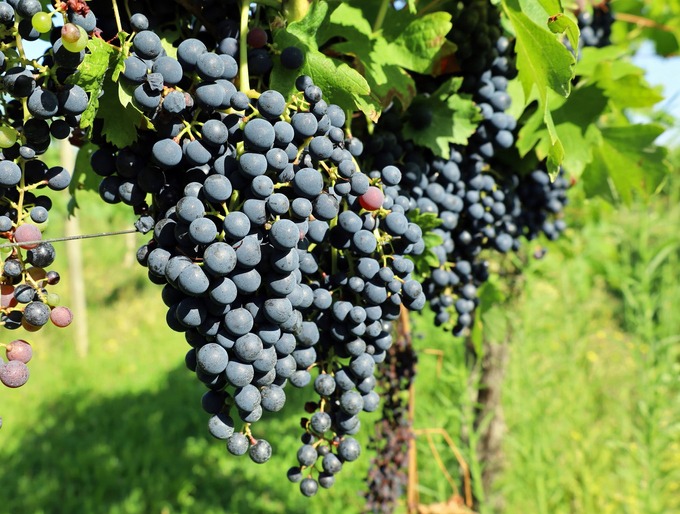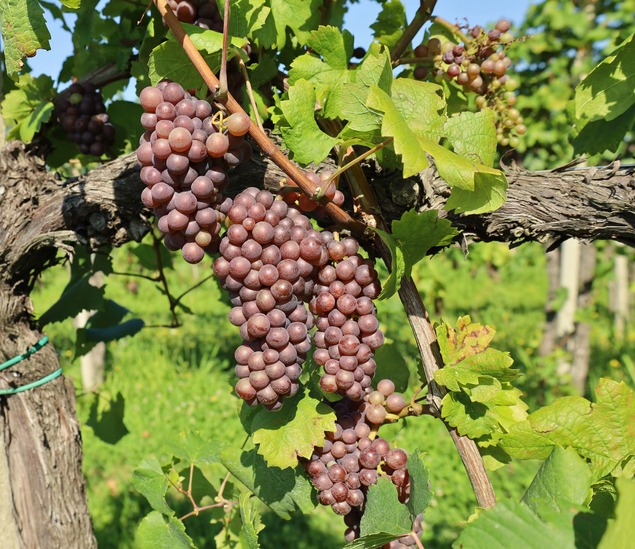Pignolo, often referred to as the “Ghost Grape,” is a rare and intriguing variety that hails from Italy. Despite its rich history and unique characteristics, Pignolo remains relatively unknown to many wine enthusiasts. This grape variety offers a distinct flavor profile that sets it apart from more commonly known grapes, making it a hidden gem worth exploring for those interested in expanding their wine palate.
In this article, we’ll take a look into the world of Pignolo, uncovering its origins, the reasons behind its rarity, and what makes its wine so special. Whether you’re a seasoned wine connoisseur or simply curious about different grape varieties, discovering Pignolo can add an exciting chapter to your wine exploration journey.
Historical Background
Pignolo’s story begins in the northeastern part of Italy, particularly in the Friuli-Venezia Giulia region. Historical records dating back to the Middle Ages mention Pignolo, indicating its long-standing presence in the area. The grape was highly regarded for its rich, robust wines, which were a favorite among local nobility and clergy. Pignolo’s deep color, complex flavors, and graceful ability to age made it a valued variety in its early days.
Rise and Decline
For centuries, Pignolo enjoyed popularity among the winegrowers of the region, contributing significantly to the local wine culture. However, the 20th century brought challenges that led to a sharp decline in its cultivation. Factors such as phylloxera infestation, World War II, and changing agricultural practices pushed Pignolo to the brink of extinction. By the mid-20th century, the grape was scarcely found, with only a few vineyards maintaining old vines.
The Renaissance of Pignolo
The late 20th and early 21st centuries witnessed a renewed interest in indigenous and rare grape varieties, leading to the gradual revival of Pignolo. A small group of dedicated winemakers in Friuli-Venezia Giulia began to experiment with the old vines, aiming to rediscover and showcase the grape’s potential. Their efforts have slowly brought Pignolo back from obscurity, highlighting its historical significance and unique qualities in the wine world.
Pignolo Today
Today, Pignolo is still considered a niche variety, but it’s gaining recognition among wine enthusiasts who seek out unusual and distinctive wines. The grape’s comeback is a testament to the dedication of local winemakers and the growing global interest in preserving wine heritage. Pignolo’s story, from prominence to near extinction and back to revival, is a fascinating chapter in the world of viticulture, symbolizing resilience and the enduring value of tradition.
Why is Pignolo Rare?
Pignolo dubbed the “Ghost Grape,” is shrouded in an aura of mystery, primarily due to its scarcity and the challenges associated with its cultivation. Let’s tackle the reasons behind Pignolo’s rarity, exploring both natural and human factors that have contributed to its elusive status.
Cultivation Challenges
- Late Ripening: Pignolo is known for its late ripening cycle, making it susceptible to early frost and adverse weather conditions. This trait requires a very specific climate and careful vineyard management to achieve optimal ripeness.
- Low Yields: The grape naturally produces low yields, which, while often associated with higher quality, can be a deterrent for commercial growers looking for more abundant harvests.
- Disease Susceptibility: Pignolo vines are prone to certain diseases, requiring more attention and care from growers to maintain healthy vineyards.
Historical Setbacks
Like many European grape varieties, Pignolo was severely affected by the phylloxera epidemic in the late 19th century, leading to a significant reduction in its cultivation. The world wars brought about widespread devastation to vineyards across Europe, and Pignolo’s limited geographical presence made it particularly vulnerable to being forgotten in the post-war rebuilding of the wine industry.
The 20th-century shift towards more commercially viable and easier-to-grow grape varieties further marginalized Pignolo, as farmers opted for grapes that promised higher yields and less risk.
Modern Revival Efforts
The modern revival of Pignolo is a testament to the dedication of a handful of winemakers who are passionate about preserving and celebrating this unique variety. These efforts include:
- Selective Breeding: Identifying and cultivating the most resilient and high-quality Pignolo vines to ensure the future success of the grape.
- Innovative Viticulture: Implementing advanced viticultural techniques to address the grape’s late ripening and disease susceptibility, ensuring healthier vines and more consistent yields.
- Marketing and Education: Raising awareness among wine enthusiasts and professionals about Pignolo’s unique qualities and historical significance to generate interest and demand.
The Rarity Appeal
The rarity of Pignolo adds to its allure, making wines produced from this grape highly sought after by collectors and connoisseurs. Its limited production, combined with the grape’s distinctive flavor profile, makes Pignolo wines a unique addition to any wine enthusiast’s collection.
Pignolo’s scarcity is the result of a complex interplay between its natural characteristics, historical challenges, and modern revival efforts. Its status as the “Ghost Grape” adds an element of intrigue and exclusivity, captivating those who are fortunate enough to experience its unique wines.
Characteristics of Pignolo Wine
Pignolo wine, derived from the rare and enigmatic “Ghost Grape,” is celebrated for its distinctive characteristics that set it apart in the world of wines. This section explores the unique flavor profile, structure, and aging potential that make Pignolo wines a coveted choice among wine aficionados.
Flavor Profile
Pignolo wines are known for their deep, complex flavors and aromas. Key characteristics include:
- Dark Fruit Notes: Expect rich layers of blackberry, plum, and cherries, often intermingled with subtle hints of forest fruits.
- Spice and Earthiness: A signature of Pignolo wines is the presence of spice, such as black pepper and clove, coupled with earthy undertones that might remind one of the truffles or forest floor.
- Herbal Accents: Some bottles may exhibit notes of dried herbs, adding to the wine’s complexity and depth.
Structure and Mouthfeel
Pignolo wines are distinguished by their robust structure and notable tannins, which contribute to the wine’s longevity and aging potential.
- High Tannins: The grape’s thick skin results in wines with high tannin content, giving Pignolo a firm structure that evolves gracefully over time.
- Acidity: Despite the richness, Pignolo maintains a good level of acidity, which balances the wine and adds to its aging capability.
- Full Body: Typically, Pignolo wines are full-bodied, offering a rich and intense sensory experience with a smooth, velvety texture that becomes more pronounced as the wine ages.
Color and Appearance
Pignolo wines are visually striking. They are characterized by deep ruby to garnet hues. The wines often present a deep, almost opaque ruby color that can evolve into garnet shades as they age, reflecting the grape’s inherent intensity.
Aging Potential
One of the most remarkable aspects of Pignolo wine is its capacity for aging. Thanks to the high tannins and acidity, Pignolo wines can age gracefully for decades, developing more nuanced flavors and aromas over time. With age, the intense fruit flavors may give way to more complex secondary and tertiary notes, such as leather, tobacco, and earthy nuances, enhancing the wine’s complexity.
Pairing Suggestions
Pignolo’s robust profile makes it an excellent companion to rich and savory dishes. It pairs well with:
- Red meats, such as beef or lamb, especially when grilled or roasted.
- Game and hearty stews that can stand up to the wine’s intensity.
- Aged cheeses complement the wine’s tannic structure and complex flavors.
Pignolo wines offer a unique tasting experience, marked by their rich flavors, firm structure, and impressive aging potential. For those seeking to explore beyond the more common varietals, Pignolo presents an intriguing and rewarding choice, embodying the depth and diversity of Italy’s viticultural heritage.
Pignolo in Modern Winemaking
The resurgence of Pignolo in modern winemaking marks a fascinating turn in the narrative of this once-nearly-forgotten grape. Contemporary vintners, driven by a passion for unique varietals and the preservation of viticultural heritage, have embraced Pignolo, integrating traditional methods with modern innovations to showcase the grape’s full potential.
Revival and Innovation
- Adoption by Boutique Wineries: Small, boutique wineries have been instrumental in Pignolo’s revival, often focusing on quality over quantity. These producers are exploring the grape’s versatility and unique characteristics, crafting wines that reflect both the terroir and the individual winemaking philosophy.
- Research and Clonal Selection: Ongoing research into clonal selection has allowed winemakers to identify and propagate the best-performing Pignolo vines, ensuring healthier plants that are better suited to local climates and soil types. This scientific approach helps in achieving more consistent yields and higher quality grapes.
Viticultural Techniques
- Sustainable Practices: Many Pignolo growers are adopting sustainable and organic viticulture practices to enhance biodiversity in the vineyards and promote soil health, believing that healthier vines produce better-quality grapes.
- Microclimate Management: Understanding and managing the microclimates within vineyards is crucial for the late-ripening Pignolo. Techniques such as careful canopy management and site selection help optimize sun exposure and air circulation, which is crucial for achieving phenolic ripeness.
Winemaking Approaches
- Old World Meets New: In the cellar, winemakers are blending Old World traditions with New World innovations. Fermentation and aging processes are carefully tailored to Pignolo’s characteristics, often involving a mix of traditional large oak barrels and modern barriques to achieve the desired balance of fruit, tannin, and oak influences.
- Extended Maceration: Extended maceration techniques are commonly used to soften Pignolo’s robust tannins, enhancing the wine’s structure and complexity without overwhelming the palate.
Marketing and Global Reach
- Storytelling and Branding: Winemakers and marketers are leveraging the intriguing story of Pignolo’s near-extinction and revival to captivate wine enthusiasts worldwide. The narrative of the “Ghost Grape” adds a layer of mystique and allure to the wines, making them particularly appealing to collectors and connoisseurs.
- International Recognition: Though still niche, Pignolo wines are beginning to gain international recognition, appearing in specialty wine shops and on the menus of fine dining establishments outside Italy. This global reach is introducing Pignolo to a wider audience, slowly building a dedicated following.
Challenges and Opportunities
The journey of reintroducing Pignolo into the modern wine landscape is not without its challenges. The grape’s cultivation and winemaking demands, coupled with its limited recognition, require significant investment and dedication. However, these challenges also present opportunities for innovation, differentiation, and the expansion of the wine world’s varietal diversity.
Pignolo’s incorporation into modern winemaking signifies a blend of respect for tradition and a drive for innovation. The efforts to revive and elevate this historic grape variety underscore the wine industry’s evolving dynamics, where the past and future coalesce to create wines of distinctive character and depth.
The Cultural Significance of Pignolo
Pignolo, with its deep roots in Italian viticulture and its dramatic journey from obscurity to revival, holds a special place in the cultural tapestry of the wine world. This section explores the cultural and symbolic importance of Pignolo, reflecting on how this “Ghost Grape” has woven itself into the heritage and identity of its native regions.
A Symbol of Resilience and Heritage
Pignolo serves as a living link to the past, embodying centuries of winemaking traditions in northeastern Italy. Its survival and resurgence represent the resilience of local viticultural practices amidst the challenges of modernity and globalization. For the regions that have nurtured Pignolo throughout its history, the grape is a source of local pride. It symbolizes the uniqueness of the area’s terroir and the dedication of its people to preserving their winemaking heritage.
Pignolo in Local Traditions
In areas where Pignolo is grown, the grape and its wines are often celebrated in local festivals and events. These gatherings not only honor the wine itself but also foster community spirit and connection to the land. Pignolo wines, with their robust flavors and complex character, have inspired local chefs and home cooks alike to create dishes that complement and enhance the wine’s qualities. This culinary synergy enriches the region’s gastronomic culture.
Artistic and Literary Inspirations
The story of Pignolo, marked by its near disappearance and subsequent revival, has captured the imagination of artists, poets, and writers. Its tale is woven into artworks, literature, and musical compositions that celebrate the grape’s legacy and mystique. Pignolo wines, with their distinct identity and depth, are viewed not just as beverages but as expressions of cultural and artistic heritage. They encapsulate the interplay between nature, human endeavor, and creativity.
Educational Impact
The resurgence of Pignolo has sparked interest among wine educators and enthusiasts in exploring lesser-known grape varieties. Tastings and seminars focused on Pignolo and similar varietals encourage a deeper appreciation for the diversity within the world of wine. The story of Pignolo underscores the importance of preserving genetic diversity in grape varieties. It serves as a case study in viticulture courses and sustainability discussions, highlighting the value of indigenous grapes to the ecosystem and cultural heritage.
Community and Identity
Pignolo has become a focal point for community gatherings and celebrations, where sharing a bottle of Pignolo wine becomes an act of communal identity and bonding. Efforts to cultivate and promote Pignolo are often part of broader initiatives to preserve cultural heritage, including language, art, and traditional practices. These initiatives strengthen the community’s sense of identity and continuity.
The cultural significance of Pignolo extends far beyond its role as a wine grape. It embodies the resilience of traditional winemaking, the richness of regional identity, and the beauty of cultural preservation. Pignolo’s revival and growing appreciation reflect a broader trend toward valuing diversity and heritage in our globalized world, making it a symbol of both the past and the future of viticulture.
Conclusion
Pignolo, the “Ghost Grape,” represents much more than just a rare variety of wine grapes. Its journey from the brink of extinction to a symbol of viticultural revival and cultural heritage showcases the resilience and richness of traditional winemaking.
As Pignolo continues to gain recognition among wine enthusiasts and connoisseurs, it serves as a reminder of the importance of preserving diversity and tradition in the ever-evolving world of wine. Whether you’re a seasoned wine lover or new to the world of viticulture, exploring Pignolo offers a unique opportunity to taste history and appreciate the complexity of wine’s cultural roots.




